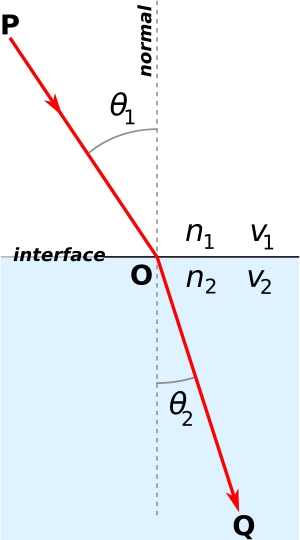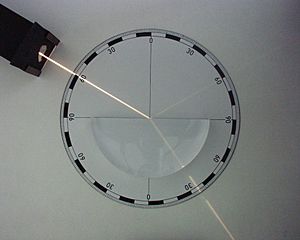Snell's law facts for kids
Snell's Law helps us understand how light bends when it moves from one material to another. This bending is called refraction. Imagine light traveling through air and then hitting a glass window. Instead of going straight, the light changes direction a little bit. Snell's Law explains exactly how much it will bend.
This law is super important in optics, which is the study of light. It tells us how the speed of light changes when it goes through different materials. For example, light travels at different speeds in air compared to water or glass.
When light enters a new material, it changes its speed and direction. Snell's Law describes the relationship between the angle at which the light hits the new material (called the angle of incidence) and the angle at which it bends (called the angle of refraction). It shows that there's a constant relationship between these angles and the properties of the materials.
Contents
What is Refractive Index?
Every material has something called a refractive index (or index of refraction). This number tells us how much light slows down when it passes through that material.
- A higher refractive index means light slows down more and bends more.
- A lower refractive index means light slows down less and bends less.
For example, the refractive index of a vacuum (empty space) is 1. Light travels fastest in a vacuum. When light enters any other material, it slows down, and its refractive index will be greater than 1.
How Does It Work?
Snell's Law can be understood using a principle called Fermat's principle. This principle says that light always travels along the path that takes the least amount of time.
Imagine you are a lifeguard on a beach and you see someone drowning in the water. You want to reach them as fast as possible. You wouldn't run straight into the water from where you are, because running on sand is faster than swimming in water. You would run along the beach for a bit, then jump into the water and swim the rest of the way. This path, where you change speed at the boundary (the shoreline), is the fastest way to get there. Light behaves in a similar way!
History of Snell's Law
The idea of how light bends has been studied for a very long time. Many smart people thought about this problem, including Hero of Alexandria, Ptolemy, Ibn Sahl, and Huygens.
It was actually a scientist named Ibn Sahl who first discovered the law of refraction around the year 984 AD. Later, in 1678, Christiaan Huygens showed how Snell's Law could be explained by thinking of light as a wave.
The law is named after Willebrord Snellius (often called Snell), a Dutch astronomer and mathematician, who rediscovered it in the early 1600s.
Images for kids
-
Christiaan Huygens' drawing to explain how waves bend.
See also
 In Spanish: Ley de Snell para niños
In Spanish: Ley de Snell para niños








